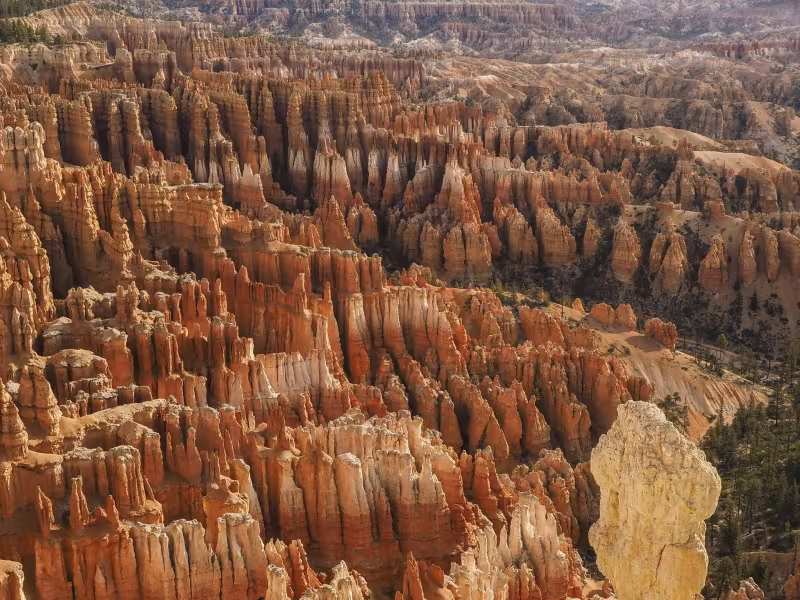
SHERIDAN, WYOMING – Feb. 14, 2025 – Utah, renowned for its breathtaking landscapes, vibrant canyons, and star-studded skies, offers an unforgettable experience for nature enthusiasts. Southern Utah, home to the "Mighty 5®" – five distinct national parks – presents a journey through majestic scenery sculpted by wind and water. This 1,013 km route, ideally explored over one to two weeks, begins at McCarran International Airport (LAS) in Las Vegas, Nevada, from where a rental car provides the freedom to discover these natural wonders.
Epic Gorges in Cedar Breaks National Monument
A 2½-hour drive from Las Vegas leads to Cedar City, a charming town near ski resorts, Dixie National Forest, and Cedar Breaks National Monument, a mere 37 kilometers away. Here, limestone arches, towers, and hundreds of red rock spires paint a stunning panorama. The 6-kilometer loop hike from Spectra Point to Ramparts Overlook Trail unveils bristlecone pines, wildflower meadows, and awe-inspiring geological formations. "From an elevation of more than 3,000 meters, the view dips into an almost 1-kilometer gorge resembling a geologic amphitheater." Camping is available at a 25-site campground (reservations recommended). Winter transforms the area into a haven for cross-country skiing and snowmobiling at nearby Brian Head Resort, boasting an annual snowfall exceeding 914 centimeters.
Natural Amphitheaters in Bryce Canyon National Park
Scenic Byway 143, passing through Panguitch, leads to Bryce Canyon National Park. Established in 1928, this park is celebrated for its beautiful, primitive, and rugged landscape. Erosion has sculpted rock spires, known as hoodoos, creating natural amphitheaters. According to ancient Indian lore, "The Coyote god petrified the greedy Legend People into stone, transforming them into lovely rock spires scattered across the canyons." The Queen Garden’s Trail, an easy 3-kilometer hike from Sunrise Point, offers an immersive experience. Expert hikers can tackle the 14-kilometer Rigg Springs Loop, traversing red rock formations and pristine forests. A drive from the visitor center to Rainbow Point showcases the park's entirety and Grand Staircase-Escalante National Monument, revealing a spectrum of pink, gray, white, pale yellow, and cocoa brown hues coloring the sandstone canyon walls. Winter activities include free ranger-led snowshoe hikes and cross-country skiing in Dixie National Forest. Summer accommodations are available at the Bryce Canyon Lodge, offering views of the hoodoos. For convenient park access, the Bryce Canyon Shuttle operates between Highway 63 in Bryce Canyon City, the park, visitor center, lodge, campground, and scenic overlooks.
Desolate Beauty in Capitol Reef National Park
All-American Road Scenic Byway 12, a Michelin-rated three-star route, winds through pine forests, canyons, and gorges to Boulder, home to the Boulder Mountain Lodge and its renowned restaurant, Hell’s Backbone Grill & Farm. Capitol Reef National Park, remote and rugged, features slickrock terrain, immense domes, jagged cliffs, and winding canyons. "Domes shaped like capitols and cliffs that serve as barrier reefs aptly gave way to the name Capitol Reef." The Scenic Drive traverses the park's heart, offering a convenient route for time-constrained visitors. Sixty-four kilometers of trails invite exploration. Fruita, a historic settlement along the Fremont River, showcases orchards planted by Mormon pioneers, where visitors can pick fresh fruit. "Enjoy the peaceful atmosphere. You just might spot mule deer and bighorn sheep in this region of Capitol Reef."
Sandstone Arches and Canyons in Moab
Moab's vast open spaces and spellbinding scenery provide a gateway to Arches and Canyonlands National Parks, both within 30 minutes of the town. Arches National Park, 10 minutes north of Moab, boasts the world's highest concentration of rock arches – 2,000. While some arches are visible from the road, many require hiking. The park is divided into sections, offering trails like the 5-kilometer hike to Delicate Arch and the 11-kilometer Devils Garden Loop. "From the desert floor, you’ll be in awe of the geologic wonders towering above you – dramatic natural stone arches deftly sculpted over time through the process of basic erosion." Canyonlands National Park features Mesa Arch, looming above a 244-meter deep canyon, an easy, less than one-kilometer trail. "Plus, Mesa Arch is an amazing photo op with vistas of neighboring buttes, canyons and red rock formations." Riverfront cabins at Red Cliffs Lodge provide overnight accommodation.
Iconic Slot Canyons in Zion National Park
Interstate 70 leads from Arches National Park to Kanab, the gateway to Zion National Park. "A photographer’s dream, Zion National Park is Utah’s most-visited national park for a reason." Multicolored canyons, grottos, natural springs, hoodoos, domes, and towers dot the landscape. The park shuttle provides access to trailheads. Highlights include the trail to the Temple of Sinawava at The Narrows, the Pa’rus Trail, Canyon Overlook Trail, and Angels Landing. Backcountry hikers will find numerous trails. Beyond rock climbing, hiking, and canyon exploration, Zion National Park is home to over 800 ecosystems and a diverse array of flora and fauna. "Be on the lookout for a variety of animals such as the peregrine falcon and the Mexican spotted owl." Cable Mountain Lodge, near the park entrance, offers accommodations with views and a spa, providing a perfect place to relax before the 3-hour drive back to Las Vegas.
For more information visit.